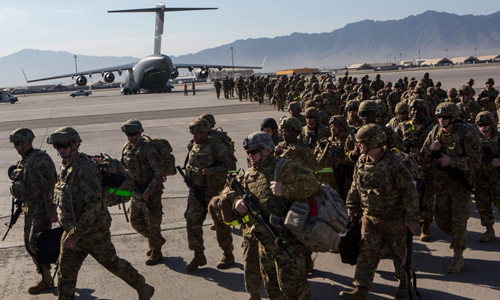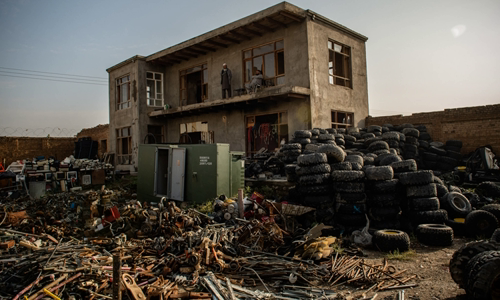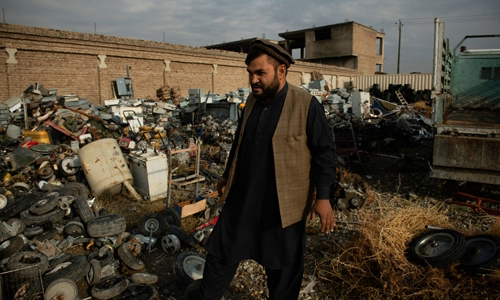Bagram, home to America's largest military base in Afghanistan, used to be a crowded town with a developed economy but it is now dying.
Nine years ago, Faiqullah Tajik used to work as a laundromat at Bagram, the largest US military base in Afghanistan. He loves this job and has earned 600 USD per month thanks to it.

US troops withdrew from Bagram military base, Parwan province in 2013 Photo: NY Times.
Like thousands of other residents living near the town of Bagram, Tavik, 25, was dismissed in 2011, when the US began to withdraw its troops from Afghanistan. Tajik now manages the store right next to the main gate of the military base, where the sale of American soldiers left behind: old treadmill, used motorbike, broken printer and computer fan. He said he now earns only $ 60 per month.
"If the Americans leave, I will close this store. I will leave," Tajik said. Because Tajik had to live on this 1,500-hectare American base to make a living, the Taliban would kill him if he returned.
Bagram has long been a main target of the Taliban, as the town's economy is completely dependent on the US military base and providing its local workforce.
As US President Donald Trump's administration negotiated peace with the Taliban and was more likely to continue its withdrawal, Tajik and the 80,000 people in Bagram felt vulnerable to American geopolitical attempt and the fate of the war. turning to the 19th year.
"The damage to the military base is now not worth it. Everyone is unhappy with the economic consequences it brings," Abdul Shokoor, head of Bagram town, pointed out the security situation. bad things go on here.
Bagram airport was built in the 1950s and became a target for a fight between the Taliban and Northern Alliance forces in the early 2000s. After the US landed in Afghanistan in 2011, the military base was expanded. the suburbs are small and there are additional runways, barracks and Pizza Hut. At that time, the base flourished with tens of thousands of residents and soldiers.
At the height of the war when more than 100,000 American soldiers fought in Afghanistan, the base was an 80% contributor to Bagram's economy, one of the 10 towns of Parwan province.

Sayeed Jamal Nasari scrap shop in Bagram in October 2019 Photo: NY Times.
More than 3,000 Afghan workers like Tajik used to live in the town of Bagram, working in and out of US bases every day. Tajik said there were mornings more than 1,000 people lined up at the base gate, but now when he comes to his shop every morning, there are only 6-7 workers waiting at the gate.
Bagram has been a "oasis" since 2014, when the US military ended combat missions and reduced the number of troops in Afghanistan. Concerned about a growing security and population problem in Bagram, the military base now has very few Afghani workers, replaced by foreign contractors.
Shokoor said the wall now completely separates the base and surrounding community. In the past, American soldiers often left bases to visit town leaders, listening to people complaining and complaining. But now, inside the long concrete wall with many watchtowers, people only hear the constant roar of the plane, sometimes with rocket attacks or bombs.
The base is frequently attacked. The worst attack was in November 2016, when a suicide bomber mixed into a group of workers sneaking into Bagram base. The bombing killed four American soldiers and injured more than 10.
The most recent was the Taliban bombing on December 11 last year, which led to a 12-hour gun battle that left at least two people dead and dozens injured.
No longer have stable jobs and high salaries on the base, many are beginning to cut back on spending at the bakery or shop around Bagram, leaving many shops forced to close or leave. Like the situation in the nearby capital, Kabul, Bagram's economic downturn forced residents to move to other places in Afghanistan, return to agriculture, join the Taliban or leave the country.
Dozens of scrap factories lying around the base are the clearest image in town, showing that the military base is no longer as strong as it used to be. Countless people who bought wood and scrap from the contractor in the base changed the town's image.

Sayeed Jamal Nasari stands at his scrap factory in Bagram Photo: NY Times.
The Sayeed Jamal Nasari scrap factory is proud to be home to many relics of the US military industry. Humvee military vehicle lights are manufactured in Aurora, Illinois; treadmill manufactured in Plymouth, Michigan; Wheel loaders in West Fargo, North Dakota ... have been among the scrap from the military base for the past 18 years.
Nasari began collecting scrap with his father 17 years ago, when Bagram air base was also a makeshift hut with a small number of American soldiers hunting al-Qaeda in the Hindu Kush mountain range. His family used to hire 100 workers at the time the base grew.
One day they bought 15 trucks full of broken equipment, pipes or furniture from pallets (pallets) or used cartridges. The amount of scrap from the American war is so great that this place doesn't have enough space to burn, bury or destroy them all at once.
According to Nasari, in the past, hundreds of shops like Tajik's would buy from his scrap yard. Customers often drive from Kabul more than 40 km away to find some items for their homes. Now there are only a few dozen shops with a truck delivering scrap from the base every day.
During the peak of the war, Nasari earned 3,000 - 4,000 USD per month. In 2014, the number of US troops in Afghanistan decreased from 26,000 to 10,000, and he earned $ 100,000 in discarded materials from their barracks.
But as the number of American and Western soldiers decreased while more and more scrap factories sprung up, Nasari's business collapsed. His workshop now has only one worker and two dogs walking around among the piles of trash and scrap.
"If the Americans leave, I just stay and sell everything here. I don't know what else to do," Nasari said.



 DavidPhillips
DavidPhillips







